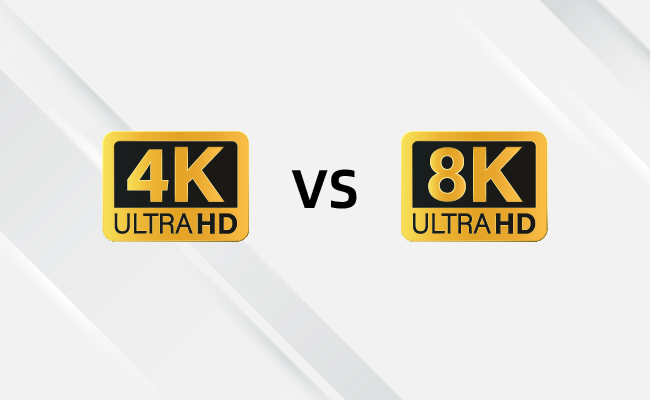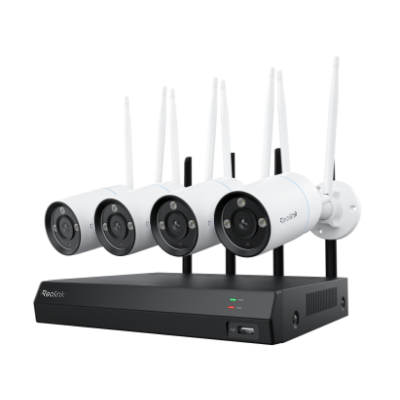4K vs. 8K: What’s the Difference?

When assessing digital devices, there’s one parameter that really matters: resolution. But rapid improvements in resolution range have happened so fast that buyers can’t distinguish between them, and that is definitely true of 4K and 8K. This article will explore the main differences between 4K and 8K.
Understanding the Basics of 4K and 8K
To unveil the differences between 4K and 8K, let's start with the basic definition of these two resolution ranges.
What is 4K?
For our purposes, 4K here refers to 4K resolution for digital devices including TVs or cameras. It is a measure of their display or image resolution and indicates a width of approximately 4,000 pixels. The most common 4K resolution standard is 3840 x 2160, though in the movie industry the 4K standard is known as 4K DCI and measures 4096 x 2160, which is a bit different.
What is 8K?
As the successor to 4K, 8K stands for 8K resolution and has a horizontal display resolution of approximately 8,000 pixels. 8K UHD 7680 x 4320 is among the highest resolutions used in TVs and other digital devices.
4K vs. 8K vs. 1080p
The main difference between 4K and 8K lies in the number of pixels counted in the resolution. 4K has 3840 pixel, and 8K has 7680 pixels. As the vertical resolution also doubles, 8K has four times the pixels of 4K. Here’s a table comparing 4K, 8K, and 1080p.
4K vs 8K: Which Should You Choose?
Today’s digital devices offer multiple resolution choices. For better image quality and vivid details for their TVs, printers, cameras, and other devices, consumers are torn between 4K and 8K resolution. Choosing the best one for you may depend on the type of device you’re buying. Here’s some guidance.
For TVs
8K resolution was first launched for televisions. Famous brands like Samsung, LG, and Sony all sell 8K TVs, but is 8K right for you? Here are the factors you need to consider.
- Image quality: You may assume that higher resolution automatically means better image quality, but that’s not necessarily true. The difference in pixel count sounds impressive, but it is hardly perceptible to the human eye. It’s only if your 8K TV is larger than 65 inches when an 8K’s image quality is truly appreciated.
- Compatible content: 4K TVs can display countless compatible programs and content, but that is not yet true for 8K. Currently, the only 8K content being produced are experimental recordings and broadcasts of major events like the Olympics and the World Cup Final, but they’re not free to the general public.
- OLED vs QLED: Your TV’s screen technology can impact your choice. OLED stands for “organic light-emitting diode,” the most commonly used TV technology, while QLED means “quantum-dot light-emitting diode.” This type of screen uses quantum dot film to enhance the TV’s color display. Most 4K TVs use OLED, while 8K ones usually utilize QLED.
- Cost: Although there are many 8K products on the market, they are still wildly expensive compared to well-established 4K models, and at an average cost of $3,000-$5,000 more than 4K OLED TVs, are price prohibitive for most consumers.
For gaming
Resolution and image quality are important to game players, but the resolution of most gaming is still 1080p Full HD, largely because a lower resolution won’t eat up too much bandwidth. 4K gaming is still not available for every game and every system, but the PlayStation 5 and Xbox Series X all claim to have 8K capabilities. The newest consoles from Sony and Microsoft will also support 8K content, including video games, but have not yet been released.
For cameras
Security camera companies know that consumers want higher resolution and greater accuracy, but there are currently very few 8K cameras available. When purchasing high-resolution security cameras, consider the following.
- Image quality: A security camera’s resolution defines its image quality. The higher the resolution is, the better image quality cameras can deliver, and with more pixels counted in an image. 8K security cameras will definitely deliver greater clarity and ore details than 4K security cameras.
- Storage and bandwidth consumption: There’s an old saying that there are two sides to every coin, and that is true when considering the benefits of different high-resolution cameras. The greater the resolution they provide, the more storage space they require and more bandwidth they take up. 4K security cameras need storage capacity of 10-80MB per minute and eat up at least 25 Mbs bandwidth in one minute. 8K security cameras storage and bandwidth requirements will likely be double what 4K needs.
For resin printers
Regarding 3D resin printers, 4K and 8K are used to gauge the resolution of the Liquid Crystal Display (LCD screen). The higher the LCD screen resolution, the more details the printed models will deliver. For more density and details, an 8K 3D resin printer will be better than 4K but will require more printing time and will cost more.
HDMI Cables: Essentials for 4K and 8K streaming
For 8K and 4K TVs to stream content, you’ll need compatible HDMI cables. HDMI is an abbreviation of High-Definition Multimedia Interface, which supports high-definition digital video and multi-channel digital audio on a single cable. HDMI cables transmit both video and audio data in a digital format.
There are three main types of HDMI cables: HDMI 1.4, HDMI 2.0, and HDMI 2.1. The difference between them lies in the distinct features they support and the speed of data transition.
All three support 4K streaming. HDMI 1.4 was developed to accommodate 4K content, and provides enough bandwidth to handle 4K video at up to 24 frames per second. HDMI 2.0 cables expanded support to 4K video at 60 frames per second with all forms of high dynamic range (HDR) and laid the groundwork for 8K.
HDMI 2.1 cables can handle both 4K and 8K video at up to 120 frames per second, with room to spare. If you’re planning on getting an 8K TV, the new 2.1 standard HDMI cable is the one you need.
Higher Resolution than 8K: 12K and 16K
If you’re wondering whether there are any resolutions higher than 8K, the answer is yes. There are a few 12K and 16K devices available, but they are rare. As is true of 4K and 8K, 12K resolution is 12288 x 6480, and provides a total of 79,626,240 pixels, equivalent to 80 MP. 16K(15360* 8640p) refers to the number of pixels found across the longest dimension of the image, and totals approximately 16,000.
Both 12K and 16K are still in their infancy. Though they are technically available, they are prohibitively expensive for everyday buyers.
4K vs. 8K in Security Camera: Meet Reolink 4K WiFi 6 Camera
4K resolution, with its 3840 x 2160 pixels, has long been hailed as the standard for high-definition visuals. In security cameras, this translates to unparalleled clarity. However, a few 8K security camera offerings are available.
Amidst this resolution rivalry, Reolink introduces a groundbreaking solution that combines the precision of 4K with the seamless connectivity of WiFi 6 technology. This innovative fusion addresses the dual demands of resolution and connectivity and provides a future-ready solution for those seeking uncompromising surveillance in an ever-evolving technological landscape.
The latest models include Reolink E1 Outdoor Pro, RLC-810WA, RLK12-800WB4. These models allow for identifying intricate details crucial for effective monitoring and come with features like color night vision, remote access, smart home integration, etc. If you are looking for 8K security cameras but have yet to encounter alternatives, consider these 4K WiFi 6 models.
4K Security Kit with Next-Gen WiFi 6
4 pcs 4K Ultra HD Security Cameras; Dual-Band WiFi 6; 2TB HDD 12-Channel NVR for 24/7 Recording; Peron/Vehicle/Animal Detection; IP67 Weatherproof.
Is 8K the Same as 16MP?
In the world of digital cameras, the terms "8K" and "16MP" are often intertwined. However, it's crucial to understand that they represent distinct concepts and dimensions within digital imaging. When we talk about 8K, we're referring to the horizontal display resolution of an image or video. An 8K display or image boasts approximately 8,000 pixels horizontally.
On the other hand, 16MP is a measure of the resolution of a digital camera's sensor. A camera equipped with a 16-megapixel sensor can capture images containing roughly 16 million total pixels. This measurement has found utility in various applications, including security cameras.
For instance, take the new Reolink Duo 3 PoE, which proudly features a 16MP resolution and integrates two lenses into a single housing. This innovative camera provides a wide 180-degree field of view, capturing even the minutest details within its frame. Users can effortlessly deploy it both indoors and outdoors for daily surveillance.
Groundbreaking 16MP Dual-Lens PoE Camera
16MP UHD, Dual-Lens, Motion Track, 180° Wide Viewing Angle, Power over Ethernet, Color Night Vision.
FAQs
Does 8K look better than 4K?
The answer is yes. With more pixels counted in a single display or image, 8K does look better than 4K, but the difference in image quality will not be obvious unless your monitor or screen is very large.
What is the difference between a 4K resin printer and an 8K resin printer?
The biggest difference lies in the resolution of their LCD screens. An 8K resin printer delivers more detail and density to the models it prints than a 4K one will. Other differences include print volume, price, and time costing. 8K printers cost more and require more time to print than 4K ones do, but 8K resin printers have greater print volumes.
Is buying an 8K TV worth it?
If you have enough budget, buying an 8K TV is definitely worth it. You'll get improved brightness, more realistic color, crisper detail, deeper blacks, and a better overall viewing experience. Plus, once they’re released, you'll be able to play 8K video and games.
Is 8K the highest resolution?
Although 8K is a very high-end resolution range, it isn’t the highest. Higher resolutions of 12K, 16K, and even 32K exist but are still in their infancy. They will eventually become the norm.
Conclusion
Both 4K and 8K resolutions deliver clear crisp images and content. They’re available in all kinds of devices, but the right resolution for a particular application is based on different standards.
We hope that this guide helps you understand the difference between 8K and 4K. Do you have a preference between the two? Leave your comments below!
Search
Be in the Know
Security insights & offers right into your inbox


